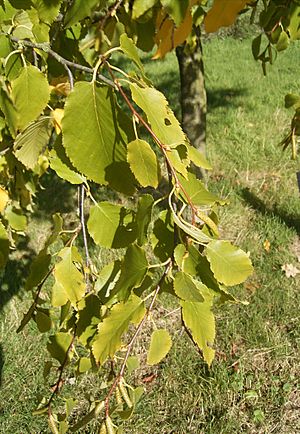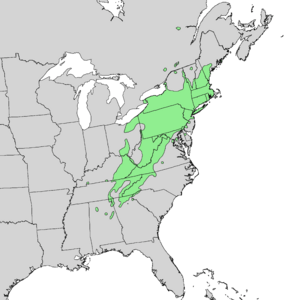Sweet birch facts for kids
Quick facts for kids Sweet birch |
|
|---|---|
 |
|
| Conservation status | |
| Scientific classification | |
| Genus: |
Betula
|
| Species: |
lenta
|
 |
|
| Natural range of Betula lenta | |
The sweet birch (Betula lenta), also called black birch or cherry birch, is a type of birch tree. It grows naturally in eastern North America. You can find it from southern Maine all the way west to southern Ontario. It also grows south through the Appalachian Mountains into northern Georgia.
Contents
What Does a Sweet Birch Look Like?
The sweet birch is a medium-sized deciduous tree. This means it loses its leaves in the fall. It usually grows about 50 to 80 feet (15 to 24 meters) tall. Some can even reach up to 100 feet (30 meters)! Its trunk can be about 2 feet (60 centimeters) wide.
Bark and Leaves
When the tree is young, its bark is smooth. It has clear horizontal marks called lenticels. People sometimes mistake it for a cherry tree. As the sweet birch gets older, its bark changes. It develops vertical cracks and scaly plates. This makes it look rough and dark brown. This rough bark is very different from the smooth bark of younger trees.
If you scratch a twig from a sweet birch, it smells strongly of wintergreen. This is because of a special oil called methyl salicylate in its bark. The leaves are oval-shaped and grow alternately on the branch. They are about 2 to 6 inches (6 to 15 cm) long and have tiny saw-like edges.
Flowers and Seeds
Sweet birch trees have flowers called catkins. These flowers are pollinated by the wind. The male catkins hang down, while the female catkins stand upright. The fruit of the sweet birch ripens in the fall. It holds many tiny winged seeds. These seeds are packed between the parts of the catkin. Trees usually start making a lot of seeds when they are 40 to 200 years old.
How Long Do Sweet Birch Trees Live?
The oldest known sweet birch tree was 368 years old! These trees might live even longer in old, untouched forests. You can get a rough idea of a tree's age by looking at its bark layers.
Bark Layers and Age
- The smooth bark of a young tree starts to crack when it's about 40 to 50 years old.
- It begins to peel off the trunk around 70 to 80 years old.
- A new layer of bark grows. This second layer starts to peel when the tree is about 130 to 150 years old.
- A third layer will peel when the tree reaches 200 to 210 years old. At this point, it's considered an "old growth" tree.
This process continues as long as the tree lives. However, it becomes harder to tell the different bark layers apart after about 250 years.
Sweet birch trees produce many seeds. They can quickly grow in areas where other trees have been removed or damaged. For example, in the Northeastern US, many trees died from insect attacks in the 1980s. Sweet birch trees often grew in their place.
What Are Sweet Birch Trees Used For?
The wood of the sweet birch is very strong and heavy. It weighs about 47 pounds per cubic foot. This wood is used to make things like furniture, millwork (like door frames), and cabinets. Its wood is very similar to that of the yellow birch. Because of this, lumber companies often don't tell the two types of wood apart.
Birch Sap and Oil
You can tap sweet birch trees for their sap, just like maple trees. The sap flows about a month later than maple sap. It also flows much faster! You can boil this sap to make birch beer or a strong syrup. This syrup tastes a bit like molasses. Boiling the sap also removes the wintergreen oil.
The inner bark of the sweet birch can be eaten raw in an emergency. You can also steep the twigs and inner bark in hot water to make tea.
In the past, people harvested a lot of sweet birch trees to get oil of wintergreen. This made the tree almost endangered until the 1950s and 1960s. That's when people started making synthetic (man-made) oil of wintergreen.
Sweet Birch and Wildlife
The leaves of the sweet birch are a food source for some caterpillars. A type of solitary bee called Megachile rubi also uses pieces of the leaves to build its nest.
Deer usually do not eat young sweet birch trees. This allows these trees to grow well even in areas where there are many deer. However, deer do eat the leaves of the yellow birch, which is a close relative. This is why you might see more sweet birch trees than yellow birch trees in places with a lot of deer. Sweet birch can also grow in thick groups in old fields. These groups can protect other trees that deer like to eat.
Images for kids
See also
 In Spanish: Betula lenta para niños
In Spanish: Betula lenta para niños



